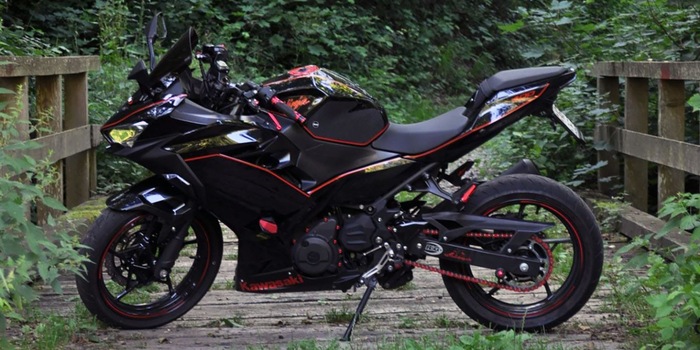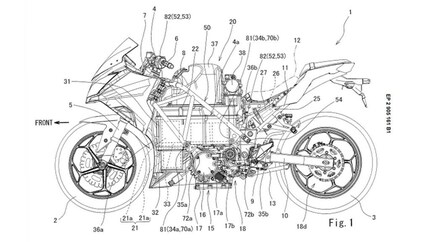
Product test
500 km with iXS Tour LT Heat ST: ready for winter
by Dominik Bärlocher

By 2035, Kawasaki wants to build only electric motorcycles. Well, not exactly. Its main markets will continue to be supplied with gasoline engines. Due to both financial and infrastructure reasons.
Kawasaki has announced its intentions to switch to e-mobility by the year 2035. This will probably mark the start of their transition from gasoline to electric motorcycle engines as well. So far, this market has been dominated by startups such as Energica and Zero – with a few forays by established manufacturers such as Harley-Davidson with its LiveWire.
But Kawasaki doesn’t quite seem ready to take this step into the future either. A shame, as the fantasy bike they featured resembles the BatPod from «The Dark Knight», making many biking enthusiasts salivate at the thought. Still, Kawasaki only wants to go 100 per cent electric in the U.S., Canada, Europe, Australia and Japan. Other markets – above all Asia – continue to be supplied with gasoline-powered vehicles.
Kawasaki – just like all the other big motorcycle manufacturers – has several reasons for not fully committing to electric bikes. There are technological limits that must be overcome. Socioeconomic reasons are also spoiling the changeover. And then there are drivers to deal with too.
When it comes to motorcycles, environmental care meets reality. Europe is a big market for two-wheelers, but real profits are being made elsewhere. The largest markets for motorcycles are:
Here money is made with small motorcycles mainly. India’s bestseller of 2020 is the Hero Splendor, a motorcycle that can go up to 125 cc, depending on the model. Cost point: 68,400 Indian rupees, or about 840 francs. Sounds like a bargain to Central European ears, and it still is, even in India. Depending on the region and its economic development.
So there is a market, with willing buyers as well. But there is a critical element missing needed before electric bikes can triumph: chargers. Currently, a total of 1800 chargers are being supplied by India’s grid. However, the goal is to reach 400,000 by 2026. Sounds ambitious. That’s because if the country started building charging stations today, working seven days a week through Dec. 31, 2026, 210 charging stations would need to be installed and operational per day.
Obviously, Kawasaki doesn’t really believe that there’ll soon be enough charging options in China or India. Or if so, not in a time frame that could be economically bridged. Therefore, the Japanese manufacturer of the Ninja, Z, and H2 series reserves the right to continue to rely on gasoline in key markets.
In Switzerland, we have an extremely high density of charging stations per 1000 people. But even here, it’s a hassle to find public chargers if you’re travelling outside of the big cities. This map, provided by the best charging app in Switzerland, clearly shows that the gaps are still too large to count as a dense nationwide network. For an electric car, this won’t really cause any problems in everyday use. However, electric motorcycles don’t have as much battery space as cars do, accordingly struggling with a shortened range and, depending on the strength of the charger, with a great deal of time lost.
If all the chargers in the SwissCharge network were made by EvTec and provided 150 kW of charging power, this wouldn’t be a problem. The 15.5 kWh capacity battery on a Harley-Davidson LiveWire could theoretically be charged in about seven minutes, if we ignore heat development in this theoretical calculation. But a 7 kW charger – of which there are still a few in Switzerland – takes over two hours using the same theoretical calculation. That’s too much.
We’ve known that Kawasaki has been working on electric motorcycles for at least two years. At that time plans came out, revealing that an electric Kawasaki Ninja was in the works.
Doesn’t sound that bad, actually. Whereas other electric motorcycles no longer have a clutch or gearshift, simply blasting off when you twist the throttle, the electric Ninja is said to emulate a gearshift. Four gears and neutral should do it. Patents have shown that the regenerative brake will be activated or deactivated by a thumb button. Batteries should be replaceable.

Sadly, all this optimism disappeared when initial specs for a prototype leaked. The electric Ninja will come with a lousy 10 kW or 13 hp engine. Range: a shameful 100 kilometres. This would make the electric Ninja about half as strong as Zero’s weakest machine, the FXE.
The specs became known in 2019. A lot has happened since then, and we don’t know whether any prototype is either ready or close to being ready for production. Making Kawasaki’s announcement all the more surprising.
Last but not least, there’s an issue with drivers, mainly in Europe. Electric motorcycles are indeed interesting to the general public. When driving the Energica Eva Ribelle through Zurich, I have to answer people’s questions. A Harley-Davidson LiveWire driver even stopped me as I exited an underground parking garage. He was surprised at the coincidence.
But on weekends, you’ll never see Energicas or LiveWires. At Ace Café, you’ll certainly hear Harleys chugging and ninjas howling. Same with Chevy’s Road Stop, Bikersbase, and all the other hangouts. You’ll often hear «Oh, I don’t want that electric garbage in my garage», «A motorcycle needs that engine sound», and «I don’t want to stop for two hours after an hour’s drive to charge my battery».
The situation is completely different when it comes to other vehicles and scooters. Agile electric motorcycles have a completely different target group. Certainly not people who get in the saddle at sunrise on the weekend and don’t arrive home until after dark. Instead, it’s anyone looking to jet to the office for a few minutes. Or students who can save a lot of cash if they charge their battery overnight in a home garage instead of buying gasoline. Removable batteries, by the way, might seem interesting to Kawasaki.
Here’s something all scooter users and those few bikers with electric experience know: electric motors can be extremely fun on two wheels. Linear acceleration is pretty neat, the more or less infinite Newton metres of pull never get boring, and electricity is much cheaper than gasoline.
What I must admit, though: I do miss the sound of a chugging engine.
Journalist. Author. Hacker. A storyteller searching for boundaries, secrets and taboos – putting the world to paper. Not because I can but because I can’t not.
Interesting facts about products, behind-the-scenes looks at manufacturers and deep-dives on interesting people.
Show all
Background information
by Lorenz Keller

Background information
by Lorenz Keller

Opinion
by Michael Restin